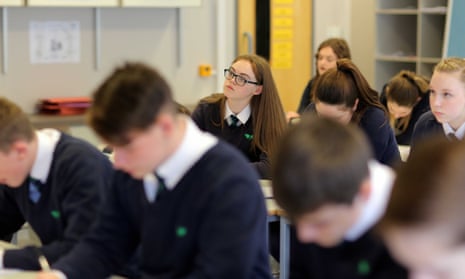Schools in England are facing the first real-terms cuts to their funding since the mid-1990s, a leading thinktank has warned.
Spending per pupil is to fall 6.5% by 2019-20, according to the Institute for Fiscal Studies (IFS), although it added that school funding had been well protected over the past two decades.
Sixth-formers have been facing a continuing squeeze on budgets, with spending per further education (FE) student falling by 6.7% between 2010-11 and 2015-16 and a further drop of 6.5% expected over the next few years. It means that funding for 16- to 18-year-olds is no higher than it was almost 30 years ago.
The IFS study examines education spending for different age groups – from early years to universities – over a number of years.
It found that the biggest spending increases over the past 20 years have been on schoolchildren in England, with £4,900 currently spent on each primary school pupil and £6,300 spent per secondary student. In both cases, this is around double, in real terms, the amount spent in the mid-1990s.
But the report shows that school spending is now falling and will drop by 6.5% over the course of this parliament. “This will be the first time schools have seen real-terms cuts in spending per pupil since the mid-1990s,” it says.
The IFS says that protections for school budgets over the last parliament mean that spending per pupil will still be similar to 2010 levels. It notes that the introduction of the national funding formula, which will redistribute money to schools in a way that ministers say will be fairer, is the “largest shakeup in school funding in England for at least 25 years”.
The IFS report warns that 16-18 education has been “the biggest loser from education spending changes over the last 25 years”, adding: “It experienced larger cuts in the 1990s than other sectors, smaller increases during the 2000s and is currently experiencing the largest cuts. This long-term squeeze in resources is a major challenge for the sector as a whole.”
Further education spending per student was 45% higher than secondary school spending in 1990 and will be around 10% lower in 2019-20.
Luke Sibieta, one of the report authors and an IFS associate director, said: “Over the next few years, both further education and schools are due to experience cuts.
“For schools, this comes on the back of very significant increases over the last few decades. For FE, this comes on the back of tight funding settlements for decades that will leave spending per student the same in 2020 as it was in 1990. The lack of priority given to FE by successive governments in spending settlements does not seem sustainable.”
A Department for Education spokesman said: “School funding is now at its highest level on record at more than £40bn in 2016-17 and the IFS has shown that by 2020 per pupil spending in schools is set to be at least 70% higher in real terms than it was in 1990.
“We are transforming post-16 education and investing £7bn to ensure there is a place in education or training for every 16 to 19-year-old who wants one.”
- This article has been amended on 27 February 2017 to correct the headline. An earlier version referred to UK schools. In fact, the study focused on schools in England.

Comments (…)
Sign in or create your Guardian account to join the discussion